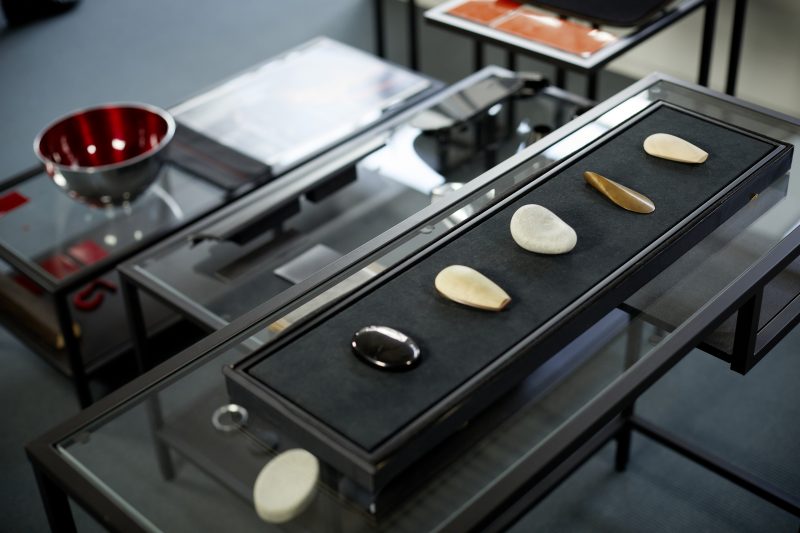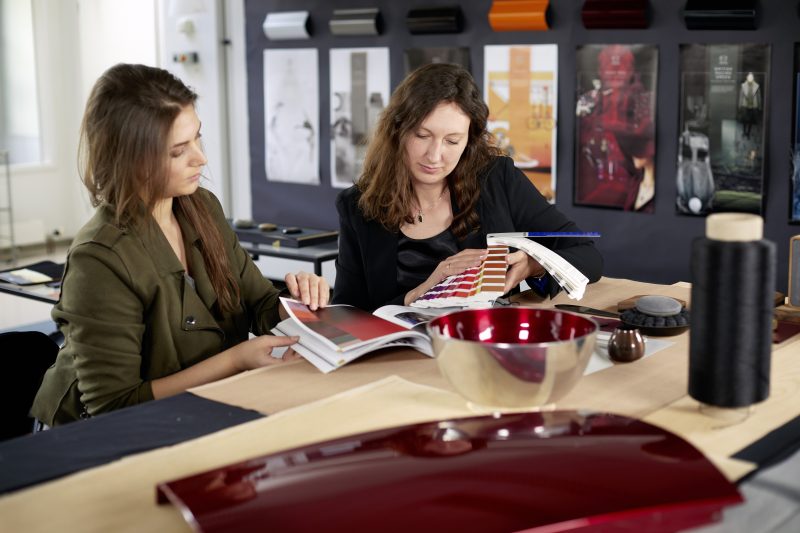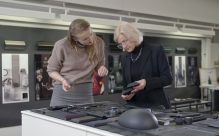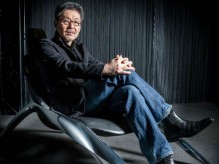“Everything can be an inspiration”
Red, black or blue? For many motorists, choosing the colour of their car is a serious business. As it should be, says Sandra Höner zu Bentrup, Colour and Material designer at Mazda Research Europe. In this interview, she explains what vehicle colours reveal about their owners, how trends can be a blessing and a curse, and why curiosity is the key to colour design.
You started at Mazda as a Colour and Material Designer in 2012. What has changed since then?
A lot, actually. For one thing, the profile of interior design and colour and trim has risen a great deal. It used to be all about exterior design, but when you think about it, we spend a lot more time inside our cars than we do admiring them from the outside. I think over the last few years, people have started to recognise how all areas of design work together to create a truly coherent and beautiful object. The way that shape and colour interact and influence each other – a central insight for our Kodo design language – was not as widely acknowledged a decade ago.
In interior design, the degree of individualisation has increased dramatically. Usually, interior design packages include a low-grade, a mid-grade and a high-grade option. With the MX-301, for example, we offer two completely different higher-grade interior styles related more to lifestyle tastes than technical features. This is an approach that gives the customer more leeway to express their own personal taste.
Why do you think the colour of their car is so important to many people?
I think colour became more and more important over time. The Model T Ford was simply black, but since then, the range of colours available has grown rapidly as people started wanting colour choice. In the 60s, for example, there were a lot of pastel, lollypop colours. And even though white and neutral colours prevailed in the 2000s, consumers still wanted to have options.
We humans are sensuous beings – we hear, we feel, we see. And the first things we see when we look at an object are its size, shape and colour. All objects have colour, whether it is from the material itself or from painting it on. Colours are just part of our environment. When we choose a certain colour, we refine a part of this environment. They are a substantial design choice that the customers can configure themselves. I think many people recognise the power of this, and that’s why colour is so important to them.
There is also a second aspect: Cars are often an emotional product, and colours are a crucial element for establishing the connection between the car and driver that we always strive for at Mazda. Our goal is to create an object that appeals to people’s emotions – before they enter the vehicle, while driving and even when they get out of the car. Colours are a great way to do this, both on the exterior and the interior. Vehicle technology is growing more and more abstract, but colour is something we can instantly relate to on an emotional level.

How do colours influence the way we perceive a car?
Design-wise, the character of a car is made up of three elements: Exterior design, interior design, and colour and trim. With Kodo, we established a design language that focusses on movement: The beauty of form, imbued with strength and vitality, is a key characteristic for our current line-up. ‘Machine Grey’ and our brand colour ‘Soul Red Crystal’ are specifically designed to enhance this character. The reflections possible with these high-grade paints best enhance the craftmanship that goes into modelling the shapes of our cars. By interacting with the environment, they make the car come alive visually. Even when the car is standing still, these high-quality paints create dynamism and a sense of movement. They combine highly reflective areas with deep shade, which creates a depth of colour that is very striking. In this case, colour actually helps define the car’s overall design character.
But even where this is not the case, there is always an interplay of the colour and the character you want to express. What associations a colour evokes, however, also depend on the exact shade and the quality of the colour. Take red: For a long time, it was mostly limited to either sports cars, because it is such a powerful and emotional colour, or very small cars, where it exudes more of a cute, young character. Putting vivid colours on larger vehicles can make them seem very bold or not very ‘serious’.
We wanted to push these boundaries and explore what the right kind of red could do when applied to a bigger car like the Mazda6 – and so we developed ‘Soul Red’. And when we enhanced the quality of the colour itself, it suddenly began to look very sophisticated and elegant. We were so happy with the result that ‘Soul Red’ became our brand colour. And the positive reactions we got from our customers confirm that red can appeal to many people, not just sports car enthusiasts, when it is done right. The same is true of all colours: Blue, for example, can look very sophisticated, but also very playful. It all depends on how the colour is executed.
Do the colour choices customers make tell us something about them?
I don’t think it’s possible to say, “a person who drives a blue car is like this” or “someone driving a red car is like that”. There are too many vastly different shades of each colour to make such sweeping statements. But I do think that the kinds of colours people choose can tell us something about them.
Neutral colours like black, grey and white, for example, are more understated, and their resale value is usually much higher than for, say, a bright green car. Drivers who choose very vibrant, individual colours are therefore likely to be making a more emotional choice than those going for neutral colours. Often, it is younger people – or those who are young at heart – that tend to favour bolder colours. They live in the moment and don’t worry too much about reselling their cars years down the road. They are more interested in making a statement and expressing their individuality. Of course, there are exceptions to this, but I think it holds true in many instances.

What colour is your own car?
My first car was red. It was built in 1992, so the colour had faded a little in some parts, but I still loved it. Since then, I’ve probably driven the entire range of Mazda body colours – I like to switch it up regularly. The one that stands out for me was the Mazda MX-5 in ‘Soul Red’ with a red door dash. That was a very clear colour statement, and a fantastic car as well. Now, I’ve switched to a more family-friendly choice with the MX-30 in solid ‘Arctic White’. For my next car, I’m thinking about ‘Machine Grey’ or ‘Jet Black’.
As someone who has been working with vehicle colour for years, do you still discover something new and exciting in these neutral shades?
Absolutely! I don’t just think of them as black, grey or white – there are all these shades in between, and just as many different qualities. Black, for example, is a really interesting colour in terms of the interplay between light and form: It absorbs most of the light, so it is very difficult to define a shape with this colour. But from improving pigments or paint technologies to evolving the shapes, we continue to find new and intriguing possibilities. Shape and colour are very closely linked, so when one changes, the other does too. It never gets boring!
What qualities does a good colour designer need?
I get asked this question a lot, and my answer is very short: Passion and curiosity. Being open and always on the lookout for new developments, exploring new avenues, scouting out the latest trends – these, in my view, are the most important traits for most kinds of design work.
Does the way you view colours differ from that of a non-designer?
Probably – I think I am just more aware of the colours around me and how they interact with each other. It’s something I do every day, and I can’t switch off this side of me when I leave the office. Also, I’m a material designer, so I always want to touch and feel everything!

Taste is subjective – how do you determine which colours will appeal to a wide audience?
It helps that we do a lot of research in advance, but once we have a colour we love, it is to some extent a leap of faith. Of course, we as a team have a lot of experience, but you never truly know how the customer will react. With ‘Soul Red’, we were pretty confident that people would like it, but we were still pleasantly surprised by the overwhelmingly positive reaction this colour received. We always hope that our customers will like a colour as much as we do, but there is no checklist and no guarantee. It needs to be the right colour, the right shape and the right time.
How do you find inspiration for a new colour?
The starting point is usually a combination of observing consumption patterns, personal inspiration and our brand vision. With Kodo design, we have started looking more deeply into Japanese ideas of beauty, so that is one big source of inspiration. Minimalism, purity and a dedication to shape – these are all important aspects of our overall design language, and they influence the direction for new colours.
I also keep an eye on societal as well as industry, product or fashion trends, and I get inspiration from all of them. A major part of my daily work as a colour and material designer is dedicated to visiting fairs or attending congresses. Professional magazines are another big source of inspiration, even in today’s digital world. Sometimes, we even find interesting or inspiring objects in everyday life, at a shop or at home – after all, we don’t just stop being colour designers after 6 pm, we are always on the lookout for new exciting directions. Under the right circumstances, everything can be an inspiration.
[1] Mazda MX-30 e-Skyactiv: WLTP electricity consumption (combined) 19 kWh/100km; WLTP CO2 emissions (combined) 0 g/km. Vehicles are homologated in accordance with the type approval procedure WLTP (Regulation (EU) 1151 / 2017; Regulation (EU) 2007/715). NEDC electricity consumption (combined)
17.3kWh/100km; NEDC CO2 emissions (combined) 0g/km. To provide comparability the referred values are NEDC – values determined in line with Implementation Regulation (EU) 1153 / 2017.




